You’ve probably read online that “content is king”.
So, you invested time and resources to implement a content marketing strategy to grow your business.
You published dozens of blog posts, Youtube videos, social media posts, and so on.
But after a while, you’re wondering if this is actually working.
You want to know exactly what the ROI of content marketing is.
You want to confirm if it actually makes sense to continue investing in content marketing or forget about it totally.
Recommended Reading: Content Marketing Basics
Then you performed a quick Google search and it looks like measuring the ROI of content marketing is harder than you think.
This makes you wonder if content marketing works.
If this sounds like what you’re facing right now, then this article will help you greatly.
In this guide, I’ll show the exact step-by-step process for measuring the ROI of content marketing.
After reading this post, you’ll know:
- Why it’s important to measure content marketing ROI
- The simple formula for calculating the ROI of content marketing, and
- Important metrics you should care about as a business owner investing in content marketing.
What is Content Marketing ROI?
Content marketing ROI is a percentage that shows the revenue made from content marketing, compared to the time and resources you invested in it.

This is a key part of any successful content marketing campaign.
The reason is simple.
If you don’t know the ROI of content marketing, you can’t identify the benefits your company gets in return for investing in it.
Contrary to what most people think, content marketing ROI goes beyond the money (revenue) you make from it immediately.
Since content marketing is a long-term game, there are a lot of metrics (which we’ll touch on later in the article) that you should measure to know if it’s actually working or not.
While some of these metrics won’t translate to money directly, it’s still important for your business in the long run.
For example, if nobody is reading the content on your blog, there’s a likelihood that you won’t make any revenue from it.
So, measuring the page views and visitors to your blog is an important ROI which you should care about.
Why You Should Measure The ROI Of Content Marketing
According to the Content Marketing Institute, only about 43% of B2B companies measure the ROI of content marketing in their organizations.
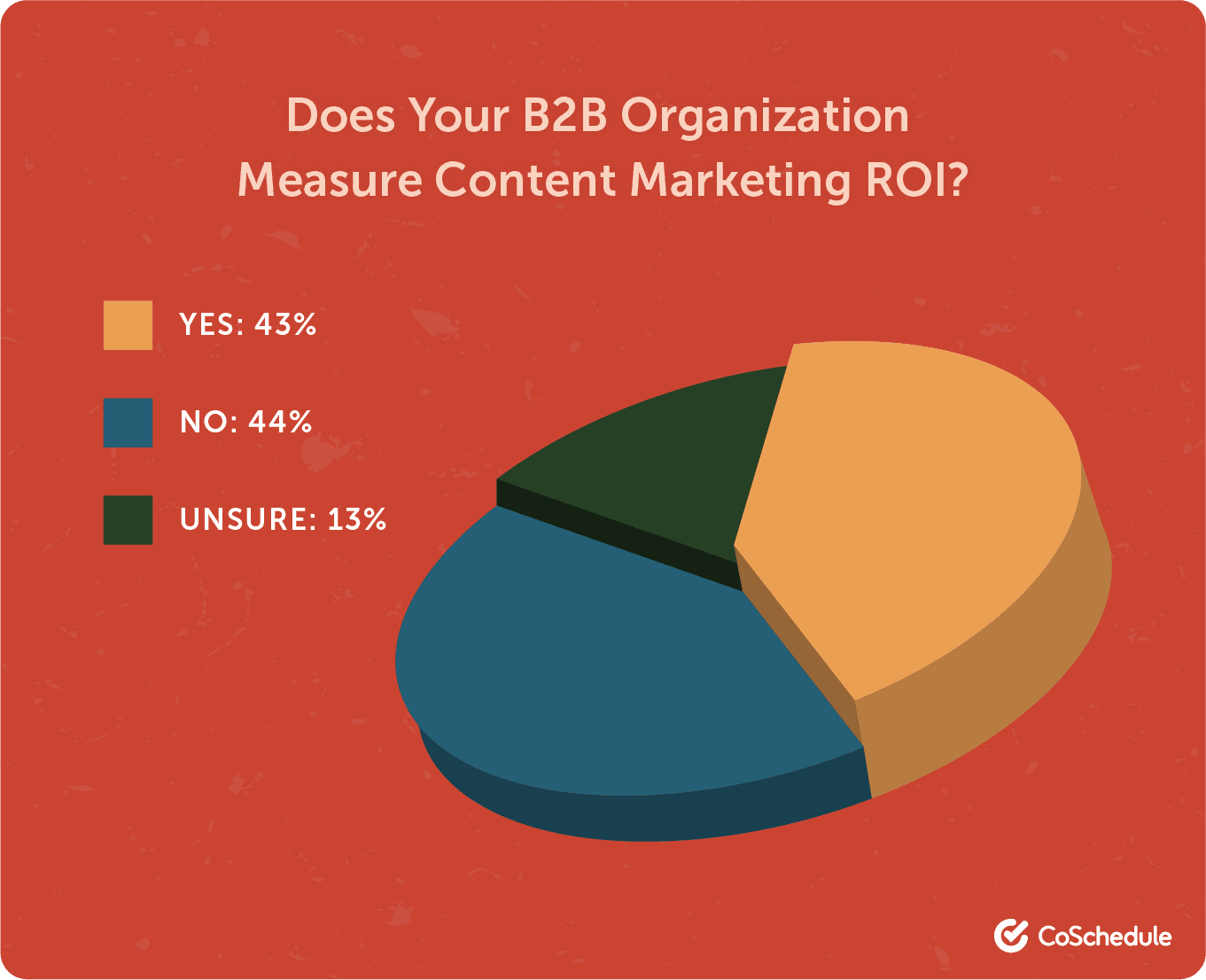
What does this mean?
While a lot of companies and business owners are investing in content marketing as a strategy, most people aren’t measuring the ROI.
Below are some reasons you should measure the ROI of content marketing for your business.
1. Prove That Content Marketing Fuels Business Growth
A lot of founders think that content marketing doesn’t have an impact on business growth. And they’re not wrong to think that way.
If you cannot show a business owner the direct impact of content marketing on their growth, they’ll be skeptical about investing in it.
That said, if you measure the ROI from your content marketing campaigns, you can prove to anyone that it is effective.
2. Get Approval For Your Marketing Plans Faster
If you work in-house, measuring the ROI from content marketing can help you get future approvals faster.
Most people believe what they see.
So, if you can show the direct and indirect impact of content marketing on your company’s goals, any marketing plans you have will be approved faster.
3. Get Company Leadership to Buy-in to Content Marketing
Investing in content marketing could be strange to your company’s leadership.
That said, if you measure the ROI and show them the numbers that matter, they’ll start paying closer attention.
Most leaders in small and large companies care about the revenue they can make from each dollar spent on marketing.
By measuring the content marketing ROI, you show them what is possible, and how it helps in growing the business.
The truth is that most companies’ stakeholders care less about the content marketing strategy you implement or focus on but care more about the ROI.
If you want to convince them to invest in content marketing, then speak the language they understand.
4 Things to Consider Before Measuring Content Marketing ROI
To successfully measure and calculate the ROI of content marketing, here are four (4) things you must put in mind to get the best results.
1. Calculate the Total Amount Spent on Content Production
For content marketing to work, you need to produce content. This depends on your company’s goals and audience. Below are some popular content types that you might be producing in your company:
- Blog posts
- Ebooks
- Videos
- Podcasts
- Webinars
- Images
- Infographics
Recommended: Free Hire Mia Writing Tools
So, the first step is to calculate the amount you spend to produce each or any of these content types.
For example, if you focus on producing blog posts in your company, then to produce any piece of content you’d most likely need the following:
- Content strategist: To provide overall strategy and perform audience research
- Content writer: To research and write the content
- Editor: To ensure that the content is well-researched and satisfies the search intent.
- Proofreader: To proofread the content for grammar, style, and so on.
- Graphic designer: To design custom images and annotate screenshots to use in blog posts.
- Content manager: To publish the content and ensure the day-to-day management of your campaigns.
Assuming that you hired each of these specialists in-house or as freelancers, and pay them about $1,000 per month.
What this means is that you spend $6,000 every month to produce content in your company.
2. Calculate the Total Amount Spent on Content Distribution
Content distribution is an integral part of content marketing. If you don’t distribute your content, no one will know if it exists.
When it comes to promoting and distributing your content, here are some platforms you can explore:
- Social media platforms (Twitter, LinkedIn, Facebook, Instagram, etc.)
- Communities (Facebook groups, Slack groups, etc.)
- Newsletters
- Slideshare
- Quora
- Medium
- Paid Ads.
For example, if your primary content distribution platform is on communities, then you’d most likely need the following:
- Content distributor: To distribute your content in relevant communities
- Community manager: To manage discussions on your posts in communities, and move them forward when needed.
Let’s assume that you hired 4 freelancers for these roles, and you pay each of them $500 per month for this task. This means that you spent $2,000 per month to distribute content in your company.
Also, if you use any software or tools to distribute the content, you’d also include that in your calculations.
Recommended Reading: Content Distribution Software
3. Calculate the Value of Conversions
The first two (2) steps focus more on the investment (aka money spent). Now is the time to figure out your ROI (aka money made).
Here is a fact: If you do steps 1 and 2 the right way, you’ll generate leads and sales from content marketing.
In some cases, people can take action immediately and become qualified leads or even make a purchase after reading your content.
For example, if you run a task management software company, you can easily convert a reader into a user signup from your content about task management.
In that case, the user signup becomes the conversion.
If you own a Shopify store, you can get people to buy from your store immediately after consuming your content. In that case, the conversion is a sale.
For someone like me who runs an agency, the sales cycle is longer. In this case, anyone who signs up for our newsletter or books a discovery session after consuming our content is the conversion.
In this step, you need to assign a figure to each successful conversion.
For example, if each user signup is worth $100 to your SaaS company, and you got 100 sign-ups in a month, that means the total value of conversions is $10,000.
4. Separate The Conversions
Here is where it gets tricky and the reason is simple.
You can’t attribute all conversions to your content marketing efforts.
In some cases, someone might have stumbled on your company’s website via a thread in a Facebook group. It’s also possible through a recommendation from a colleague at work.
All you need to do here is measure the leads that you can attribute directly to content marketing and leave out the rest.
You can use analytics tools such as Google Analytics, Hotjar, Smartlook, Crazyegg, etc. for this purpose.
Once you’ve separated the conversions, you can now calculate the total amount you made from content marketing.
Assuming that you found out that 70 users who signed up for a free trial of your SaaS product came from organic and social media traffic.
This means that you can attribute $7000 in revenue to content marketing, based on the previous calculation.
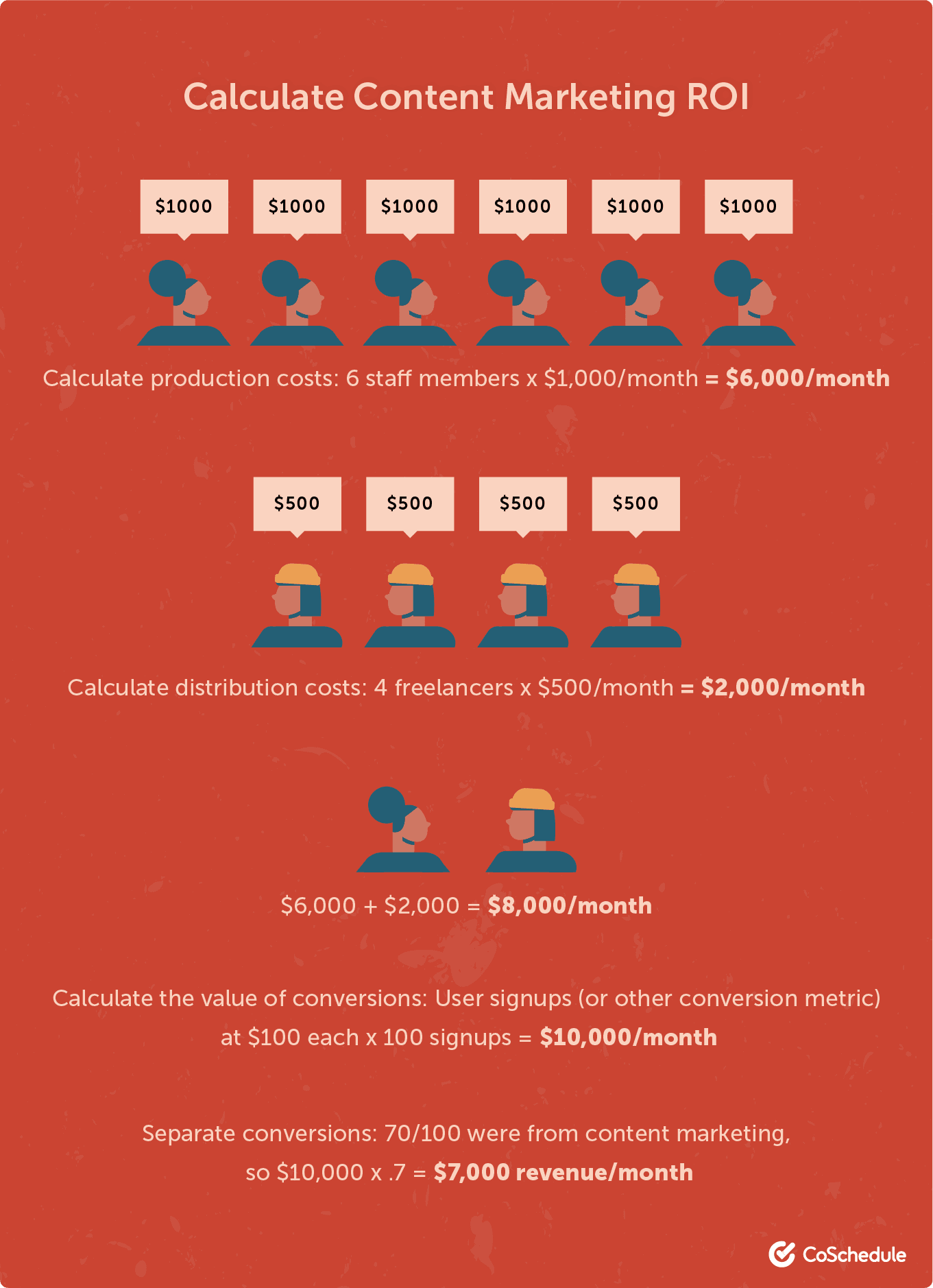
The Simple Formula To Calculate The ROI Of Content Marketing
The most popular formula for calculating content marketing ROI is the return minus total investment, divided by investment. This answer is usually expressed as a percentage (multiplied by 100).
Content Marketing ROI = Return – Investment X 100
Investment
Using our previous example, here’s how this ROI would be calculated:
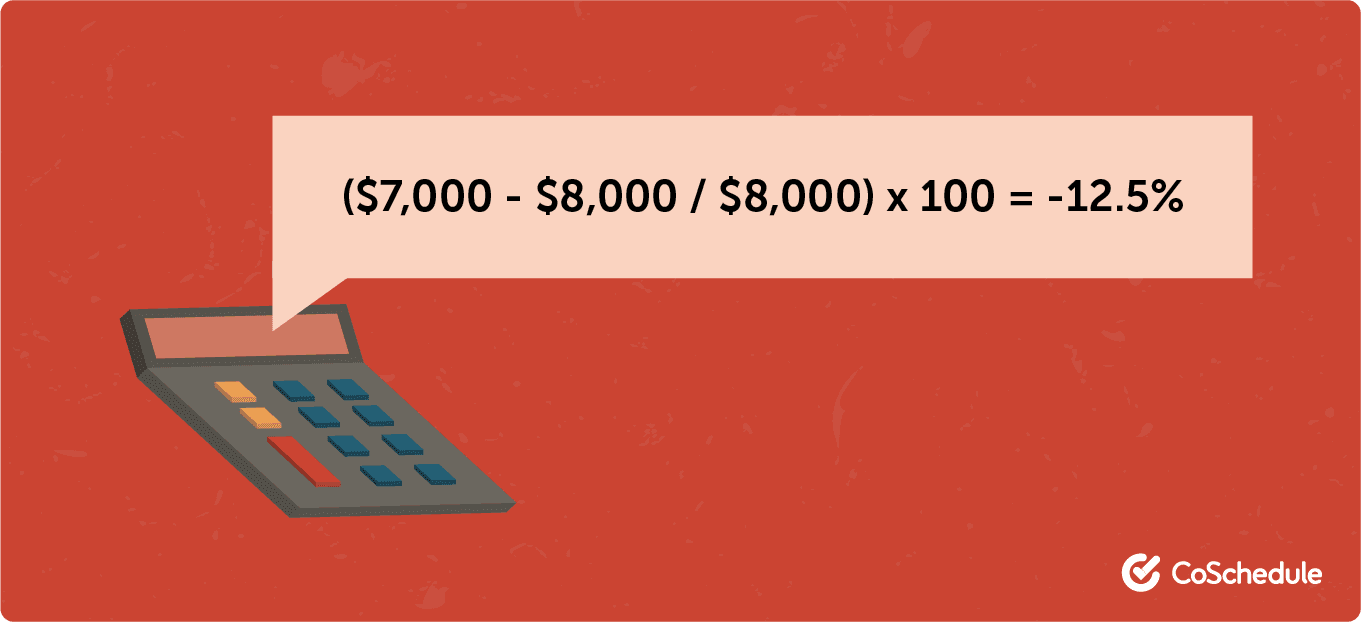
If you’re in the red like our example above, try to find ways you can either reduce production costs or increase your return.
Here are some other examples to help you understand this better:
Say you run a SaaS company, and spend around $3000 per month to invest in content marketing.
At the end of each month, 200 new users who signed up for a free trial were due to your content marketing efforts.
Assuming that each user signup is worth $50 to you, then your total return would be $50 X 200 = $10,000.
In this case, your content marketing ROI will be [($10,000 – $3000)/$3000] X 100 = 233.3%
Here is another example…
Let’s say you own an eCommerce store and spend around $2000 per month to invest in content marketing.
At the end of each month, you sold 150 units of a $49 product, which you can directly attribute to your content marketing efforts.
What this means is that your total return would be $49 X 150 = $7350.
Hence, your content marketing ROI will be [($7350 – $2000)/$2000] X 100 = 267.5%.
One final example to wrap things up here.
Let’s say you own a digital marketing agency, and your team spends about $5000 per month on content marketing.
At the end of each month, 30 persons who booked a discovery session with your lead strategist are from your content marketing campaigns.
Let’s say that each successful call booked is worth around $400 to you.
This means that your total return would be equal to $400 X 30 = $12,000.
Hence, your content marketing ROI will be [($12000 – $5000)/$5000] X 100 = 140%.
How To Measure Content Marketing ROI: Metrics That Matter
The Most Important Content Marketing Metrics
- Marketing Qualified Leads (MQLs)
- Sales
-
- Page value
- Transactions
- Conversion rates
- Time to purchase
- Assisted conversions
- Social Media Engagement
-
- Likes
- Comments
- Shares
- Page/post views
- Followers
- Email Marketing Success
-
- Email subscribers
- Open rates
- Click-through rates
- Unsubscribe rates
- SEO Success
-
- Organic traffic
- User engagement
- Number of backlinks acquired
- SERP rankings
It’s impossible to measure everything in content marketing.
The key is to focus on important metrics that align with your company’s goals, industry, and so on.
For example, if you published a data-driven report, your goal will most likely be to acquire links.
In that case, it’s better to measure the number of links you got from that campaign, instead of trying to measure something else.
Also, if you’ve published an eBook on a specific pain point that your audience is facing. The goal would most likely be to get more brand exposure and leads for your business. So, it makes sense to focus on measuring that alone.
Below are some common content marketing metrics that you might consider measuring for your business.
1. Marketing Qualified Leads (MQLs)
For most content marketing campaigns, MQLs are important.
The reason is simple.
The more leads you have as a company, the more people you can sell to.
So, the number of qualified leads you got from your marketing efforts, shows if it’s paying off or not.
According to the Content Marketing Institute, you can spend 62% less to generate more leads from content marketing compared to outbound marketing.
However, you don’t want to measure any type of leads. You only want those who are qualified to do business with you.
So, how exactly can you know that?
There are a lot of ways to do so. Here are some ideas:
Take, for instance, you’ve just written an ultimate guide with a lead magnet to generate leads.
You can tell if you’re generating the right leads that’ll move the needle for your business if:
- People are downloading the lead magnet after reading the guide
- Readers are reaching out to your sales team to ask specific questions
- Visitors are taking action after downloading the lead magnet, such as sharing it with their audience on social media or emailing their friends about it.
- They don’t stop at reading the ultimate guide alone. Rather, they check out other related articles and resources on your website.
With actions like these, you’re most likely attracting qualified leads, who will likely buy from you in the long run.
2. Sales
Attracting leads isn’t enough. You need to work on converting the leads you generate into sales.
This is because, without making sales, you’ll run out of business.
The strategy most content marketers use is to nurture leads continuously through the sales funnel until they make a purchase.
Let’s say someone downloaded your content upgrade to become a lead.
Since you have their email address, you can send targeted emails and content to them. In the long run, some of them will make a purchase, if your product or service is something that resonates with them.
In order to measure your sales, here are some specific metrics you should be looking at:
- Page value: This value gives you an idea of the page(s) that contributed more to your site’s revenue.
- Transactions: This metric measures the sales activity on your website.
- Conversion rates: This shows the percentage of visitors on your website that make a purchase.
- Time to Purchase: This shows you how long (days or weeks) it took for website visitors to convert into customers.
- Assisted conversions: This allows you to understand and measure other actions your user took (such as visiting another website), before making a purchase.
To get this data and many more, you should consider setting up eCommerce tracking on Google Analytics for your website.
3. Social Media Engagement
Social media has come to stay.
According to Data Reportal, there are over 4 billion social media users around the globe right now.
If you run a content marketing campaign, the engagement on social media will go a long way to show if it actually works or not.
Common engagement metrics you should check out for on social media include likes, shares, comments, etc.
On most social media platforms, you can track the results you get from a specific social media post.
On LinkedIn, you can know the exact company, location, and job title of those who viewed and engaged with your post.
Here is an example from a LinkedIn post promoting this article on content writing for SaaS companies.
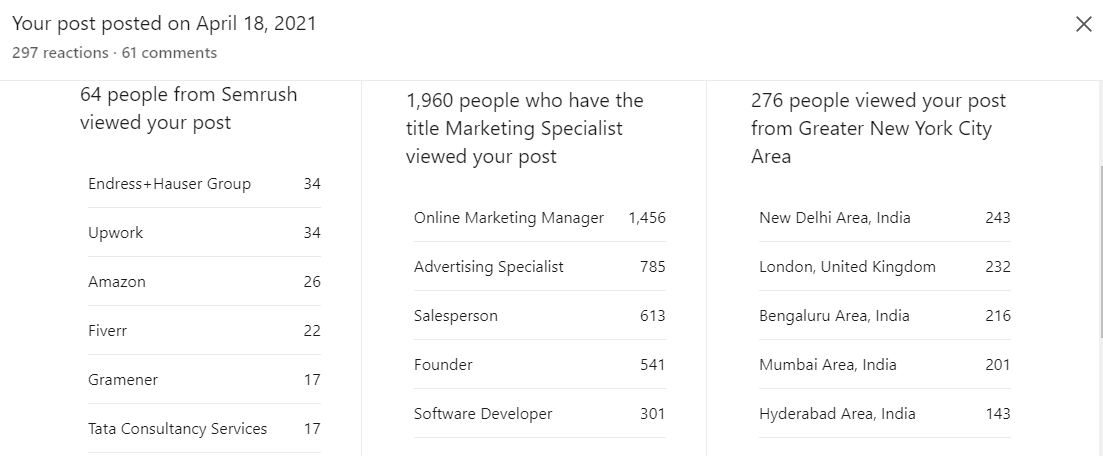
As you can see, employees from companies such as Semrush, Amazon, Upwork, Fiverr, Gramener, etc. saw my post.
Not only that…
People with job titles like Founder, Marketing Specialist, Online Marketing Manager, Software Developer, and so on, also viewed the post.
A metric like this shows me the demographic of my target audience. Hence, I know what to focus on next time.
Other premium tools such as Shield provide a more in-depth report about your LinkedIn content performance.
On Twitter, you can analyze your daily, weekly, and monthly tweets performance using the free analytics tool on your PC.
Other tools such as Google Analytics, Buzzsumo, Buffer, ilo, and so on are also great for measuring your social media performance.
Recommended Readings:
4. Email Marketing Success
Email marketing is one of the most effective content marketing channels out there.
So, if your email marketing strategy is successful, it shows that your content marketing strategy works.
The first thing you want to measure here is the number of email subscribers you have.
If you have a high number of email subscribers, it shows that your target audience wants to hear from you.
If the number of subscribers on your email list is low, then you need to work hard on improving that.
Aside from email subscribers, you also want to watch out for your open rates and click-through rates.
For the open rates, it’s the percentage of people who opened your emails on their devices.
For example, if you have an email list of about 1,000 subscribers, and about 100 of them opened your email, this means you have an open rate of 10%.
The Click-Through Rate is the percentage of people who clicked on the link(s) in your emails.
For instance, if you sent an email to a list of 1,000 subscribers and only 20 of them clicked on the link inside it, that means you have a 2% click rate.
From experience, the click rate is usually lower than the open rate.
This is because not everyone who opens your emails will click on the link(s) inside it.
Finally, you also want to measure your unsubscribes. This is the number of people who decide that they don’t want to hear from you again.
There is nothing you can do about this, since people can subscribe and unsubscribe at will.
However, you have to check if the unsubscription rate is unusual. If it is, you might need to reduce the frequency of your emails or the offers you make in each one.
Recommended Readings:
5. SEO Success
SEO is a core part of any content marketing program. So, measuring to see if it’s actually working is something that you must do.
Below are some specific metrics you need to measure for SEO:
Organic traffic:
Organic traffic is the traffic to your website through a search on Google or other search engines.
You can measure how and where your organic traffic is coming from using Google Analytics.
You can also use Google Search Console, to understand the keywords that people are searching for before stumbling on your website.
Not only that, the pages that are driving the most impressions and clicks on your website.
Other SEO tools such as SEMrush, Ahrefs, Moz, etc. provide you with an estimate of the results from organic traffic.
If you’re getting lots of organic traffic, it shows that your investment in content marketing is paying off. You just need to focus on converting the traffic into leads and sales for your business.
Recommended Reading: SEO Content Strategy
User engagement:
User engagement is a measure of how visitors and users engage with the pages on your website.
This is important because the primary reason for investing in content marketing is to attract, educate, and engage your audience.
So, if you’re able to attract them through SEO or other means, then they need to spend some time on your website before you can educate or engage with them.
Hence, you should check user engagement metrics such as time on page and bounce rate.
Time on page is the number of minutes that a user spends on a specific page on your website.
If the average time on page is low, it shows that users aren’t engaging with your content. However, if it’s high, it means that they found the content engaging, and are spending more time consuming it.
Bounce rate is the percentage of visitors that leave a webpage without taking an action.
Examples of actions are: clicking on a link, navigating to another page, filling out a form, making a purchase, etc.
If your bounce rate is high, you’ll most likely not convert your traffic into leads and customers for your business.
However, if it’s low, it shows that your website visitors are taking action, and would most likely convert into leads or customers.
This article by Backlinko explains what a bounce rate is, and how you can improve it.
Recommended Reading: How To Use AI For SEO
Number of backlinks acquired
The number of backlinks your website and pages acquire is a good way to measure the success of your investment in SEO and content marketing.
The reason is simple.
Backlinks matter in the eyes of Google.
In fact, multiple SEO studies have shown that there’s a clear correlation between the number of backlinks that a website or page has and its rankings on Google.
So, if you acquire more backlinks, it’ll help your website and pages to rank higher.
Recommended Reading: Backlink Monitoring Tools
There are a lot of ways to know the number of backlinks that a website or page has.
For example, using Ahrefs free backlink checker, here is the total number of backlinks to CoSchedule’s website.

You can also use other tools like Moz, SEMrush, Majestic, and so on for the same purpose.
Top ranking in the SERPs
Your ranking on the SERPs is an indication of your SEO success or failure.
If your pages don’t show up when you search for your target keywords on Google, it shows that you still have a long way to go SEO-wise.
On the other hand…
If your pages rank in the top 3 spots on the SERPs, it shows that you’re doing something right, and will definitely get results from SEO.
The easiest way to know how you’re faring on the SERPs is to search for that keyword on Google preferably in an incognito window.
For example, when I searched Google for the keyword “social media calendar”, here’s the result that I got.
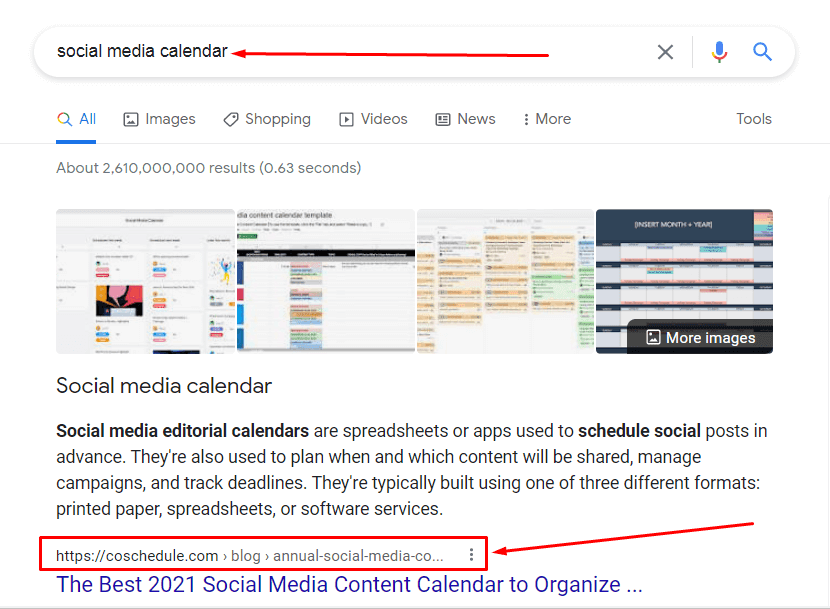
As you can see, CoSchedule is occupying the top spot in the SERPs for a keyword, which is relevant to its business.
